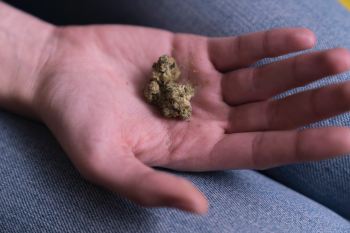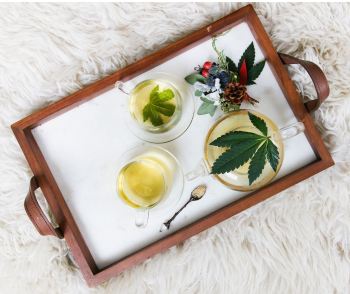How CBD Oil is Made: Introduction
CBD (Cannabidiol) is becoming ever more popular today, now being incorporated into many products such as topicals, drinks, and even as massage oils.
Many swear by CBD’s amazing effects, helping them treat anxiety, depression, and other ailments.
CBD can be extracted through many different methods. We’ll discuss them below, so read on!
Cannabis has two main ingredients often sought after. The first is THC which is the psychoactive component (the one responsible for making you feel “high”). The other is CBD, which is another cannabinoid found in the plant with many benefits.
Steps of CBD Production
Step 1: Selection of the plant
The first step to making CBD is to select a plant that’s naturally high in CBD!
Obviously, if we want the maximum amount of CBD possible, we would look for a potent strain of hemp.
Many extractors develop their own unique strains of the plant, selecting for CBD content through multiple generations. Most of them have strains with little to no THC and high CBD, in order to avoid the costly process of having to remove the THC.
Because most of these plants have low THC content (<0.3 percent, which is the legal limit), they’re not considered “marijuana” plants, but rather just “hemp”. This is despite the fact that it’s technically the same plant.
Now,
I know you’re now thinking that all of this seems to be in a legally blurry area, but under law, anything below 0.3% THC is perfectly legal! So there’s no need to worry.
Step 2: Growing and Harvesting the Hemp
Once the hemp plants have been selected and a strain with high CBD is obtained, the next step is to grow the plants.
Many hemp farmers today are not in the business just for the financial benefits of it. Some have experienced the healing effects of cannabis first hand and then decided to grow the plants themselves after seeing the surprising benefits.
In general, the hemp growing season runs from May to October.
Sometimes plastic is laid down around the plants to keep weeds at bay. The plants are watered as needed depending on moisture requirements and the water pH level is maintained.
In october, the plants are harvested.
As a side note: not all hemp used for producing CBD in the US is locally grown. Some is imported from other countries such as Canada, countries in the European Union, and even Asia (mostly from China specifically).
As for the plants harvested, they are then left to air dry for a while (typically a few weeks).
The flower of the plant is then stripped off and the rest of the plant is discarded. The flowers are then ground into a coarse powder.
Step 3: Extraction
After the plant flowers are ground, they are subject to an extraction process. Extraction processes can vary and there’s multiple methods, each with their own benefits.
Here, we’ll discuss methanol extraction.
In this type of extraction, the flowers are mixed in with methanol to remove unwanted terpenes. The terpenes diffuse into the methanol and the methanol is then removed, removing the terpenes with it.
After that the plant, the plants go through a cooling process, sometimes called “winterization”. This helps separate the fats, which are removed from the mixture.
Next comes distillation. The mixture is heated and the fractions separated by cooling them in a column.
Step 4: Lab Testing
After the distillation, the final mixture is subjected to testing. Typically the company that does the testing is unaffiliated with the hemp growers to ensure independent and unbiased results.
A variety of tests are run. These tests measure the amount of THC which needs to be below 0.3% (except in states like california where a higher THC content is legal).
They also test for CBD, CBDV, CBG, and other major cannabinoids found in hemp.
Some labs also test for terpenes in the oil.
Most tests will also include a test for microbes, heavy metals, and pesticides.
Once good results are confirmed, the CBD oil can then be further processed.
Step 5: Final Processing
The CBD is then bottled with a carrier oil, typically MCT for tinctures as MCT increases absorption of the oil.
The oil may also be added to soaps, lotions, balms, bath bombs, rolls, even honey, gum, and chocolate!
There’s also many other products on the market today infused with CBD, with more continuously being made, so be on the lookout!
The CBD oil products are then finally branded and sold to consumers.
The Different Types of CBD Extraction
We discussed above the methanol method of extraction of CBD, but other methods of extraction also exist.
The different methods of extraction each have their own unique benefits, such as the ability to preserve terpenes well or extract more cannabinoids out of the plant.
Below, we’ll discuss the alcohol extraction method in more detail, and also discuss the other major method that you’ll see very often, CO2 (carbon dioxide) extraction.
Alcohol Extraction
Alcohol extraction is often considered one of the first methods that was used at scale for CBD extraction, and Rick Simpson has been credited with developing this technique.
Before alcohol extraction, methods such as simply grounding and straining oil out of the CBD plants using pressure were used, but those methods don’t produce a product with the same level of concentrated CBD.
Alcohol extraction starts by soaking the ground hemp plant flowers in alcohol. Above we talked about methanol being used as the alcohol, but other alcohols such as ethanol can also be used.
Each alcohol has unique properties and can extract different ratios of certain compounds from the plant, so different alcohols may be used for each purpose.
After the mixture soaks, it separates into two parts with one containing a liquid that has the CBD and cannabinoids.
The solvent of this liquid can be evaporated through heating leaving a CBD hemp oil remnant.
After soaking in the alcohol the CBD-filled ethanol solution can also go through a Roto-Vap which heats alcohol-containing mixture induce quick evaporation. This helps recapture the alcohol for reuse later. The CBD oil is left behind in a separate container.
CO2 Extraction
Another way to extract CBD from hemp is the CO2 extraction method.
The gist of this method is that you force CO2 through the plant, which carries CBD (and other compounds) with it out of the plant.
This technique is a bit more complicated than the alcohol extraction method. It requires more technical skill, in addition to specific machines that can carry out the needed pressurization and cooling of CO2.
A series of CO2 chambers is required for this technique to work. These chambers keep the CO2 under high pressure and low temperature which converts the gas into a liquid.
When this solution of liquid CO2 is passed through the plant, it extracts cannabinoids from the plant as it moves through.
The different chambers can collect the cannabinoids separately. Once the cannabinoids are collected, they can then go through the rest of the process.
Further Processing of CBD for Commercial Use
Many CBD oil extracts are also subjected to decarboxylation. This process involves heating the cannabinoids in order to induce removal of “carboxy” groups from the cannabinoids. Removal of these groups helps make the cannabinoids more readily available for use in our bodies.
Decarboxylated cannabinoids are also capable of interacting with endocannabinoid receptors immediately once they enter into circulation.
Extracted CBD usually does not taste good at all. For this reason, it is often mixed in with other components.
Consumers also often want different concentrations of CBD since dosage can differ according to someone’s weight or their sensitivity to CBD. So the CBD is diluted with other oils.
Pure CBD can be consumed directly, but due to popular demand and preferences of consumers, CBD is offered in a wide array of products such as pills, tinctures, and lotions that can be applied to the skin.
Conclusion
In summary, the process of making CBD is a complicated one involving many steps.
Producing good quality CBD starts with selecting the right type of plant, which may take years to breed and select for.
Using a plant strain with naturally occuring high CBD content and low THC content is essential as it ensures extracting large quantities of CBD.
It also allows for extracting an oil with a low THC percentage so it’s legal and won’t get the user high. This is also important as it keeps the oil within legal limits so the consumer does not get into any trouble.
After the plant is selected, the next step is to extract the oil, which can be done using many methods.
The most common methods are alcohol extraction and CO2 extraction, with the latter generally considered better.
Once the CBD is extracted, it is then bottled and ready to ship to you to help you with any ailments!
If you have any comments or questions about how CBD is made, please leave them below. We’ll gladly help answer your inquiries when possible.
